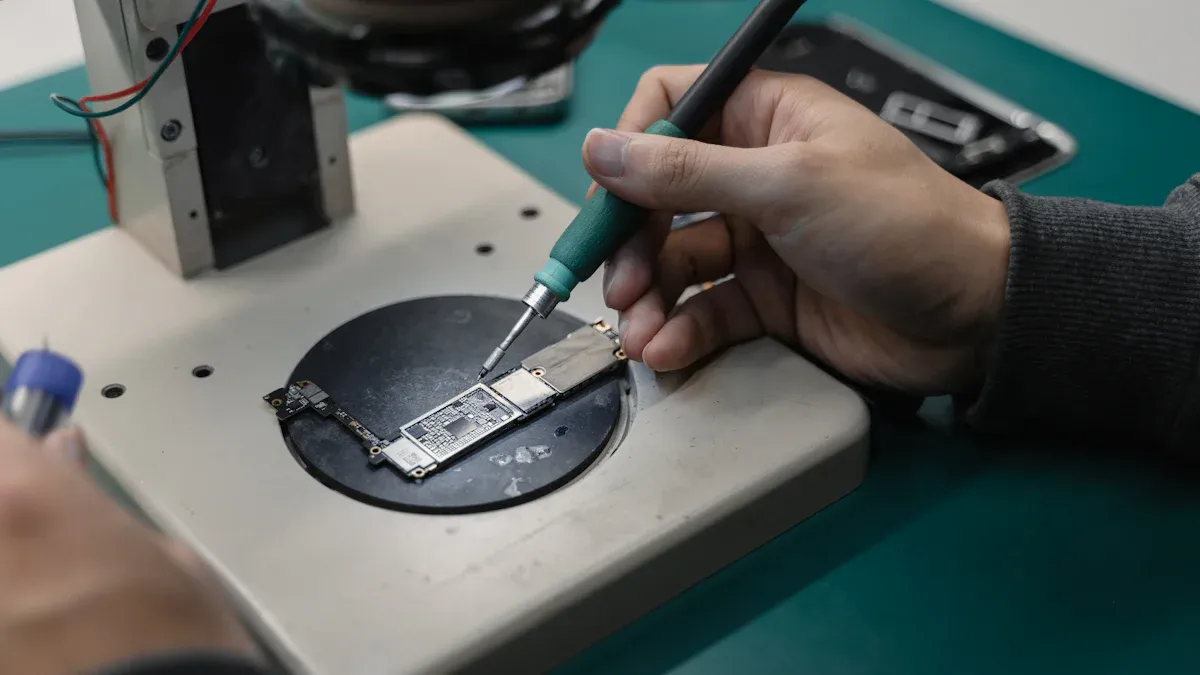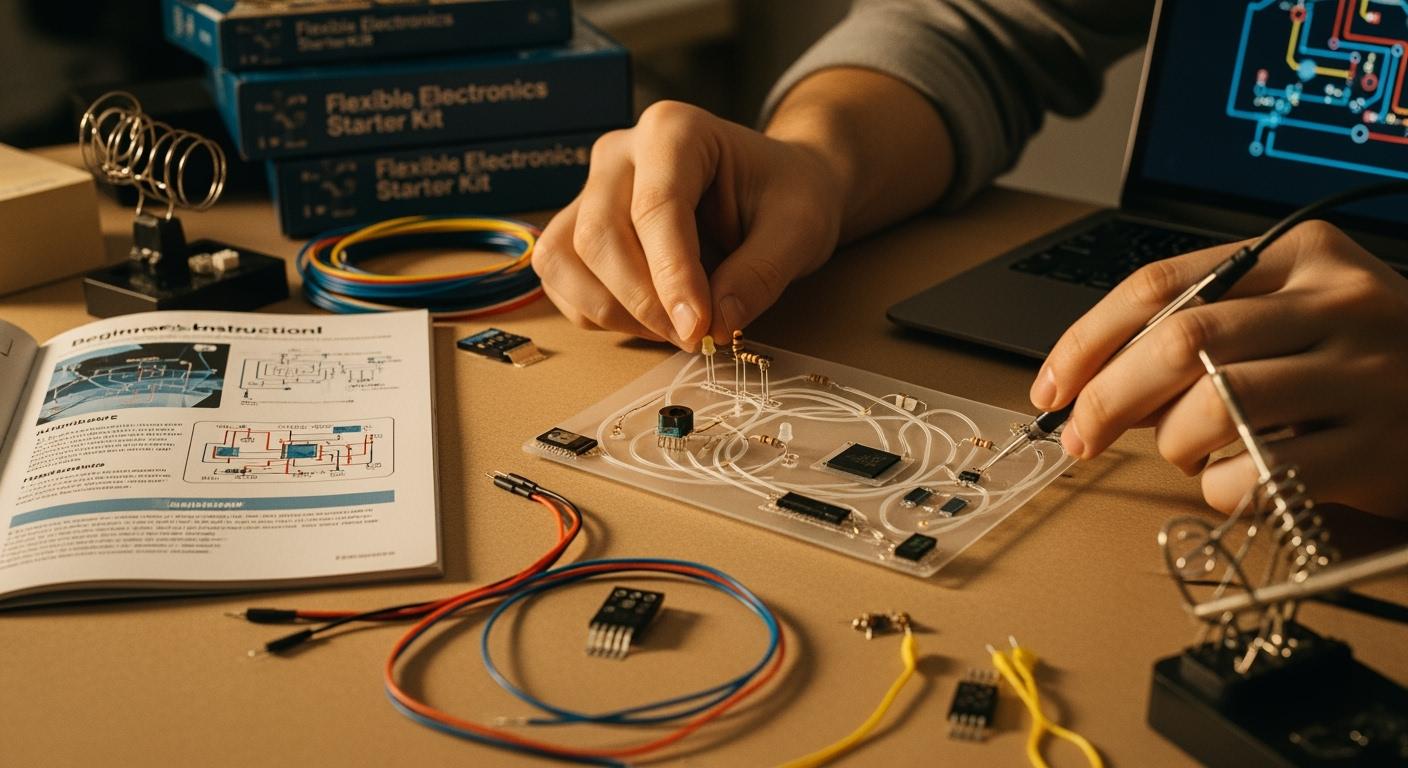You can start your electronics journey with the best electronics kit for beginners. Popular options include classic electronics kits, the best electronic kit for hands-on learning, and stretchable circuits kits. These kits make electronics accessible for all ages.
- Hands-on electronics kits help you build practical skills, improve problem-solving, and understand concepts like Ohm's Law.
- The global stretchable devices market reached US$ 484.47 million in 2023 and is set to grow rapidly.
| Subject Area | Learning Outcomes |
|---|---|
| Science | Understanding energy transformation and electrical flow |
| Engineering | Practicing problem-solving and design thinking |
| General Learning | Building circuits from scratch and modifying designs |
Explore reviews and the buying guide to find the right kit for your goals.
Key Takeaways
- Start your electronics journey with beginner-friendly kits that match your skill level and interests. This approach helps you learn faster and enjoy the process.
- Choose stretchable circuit kits for hands-on learning. These kits allow you to build practical skills while exploring concepts like energy transformation and electrical flow.
- Select materials like TPU or silicone for your projects. These materials are easier to handle and provide reliable results, making them ideal for beginners.
- Consider the complexity and cost of kits before purchasing. Simple kits are budget-friendly and great for quick learning, while advanced kits may require more investment and time.
- Join online communities for support and sharing your progress. Engaging with others enhances your learning experience and keeps you motivated.
What is stretchable circuits?

Stretchable circuits are a new type of electronic technology that can bend, twist, and stretch while still working. You can use these circuits in many modern devices, especially where flexibility is important. Stretchable circuits have several key features:
- They stretch and return to their original shape without losing electrical performance.
- They fit on curved or moving surfaces, making them ideal for wearable technology and medical devices.
- Materials like rubbers and elastomers give them resilience and flexibility.
You will find stretchable circuits in wearable health monitors, smart clothing, and diagnostic equipment. These circuits use special materials that allow them to handle stress and movement.
Folding Limit
When you work with stretchable circuits, you need to know how much they can fold or bend before breaking. The folding limit tells you how far you can bend a circuit without damaging it. Most stretchable circuits use materials with a low Young’s modulus, which means they can stretch a lot before snapping. Polymers with high elongation at break and a high Poisson’s ratio are common choices. This makes the circuits safe for repeated folding and stretching.
Minimum line width and maximum number of layers
The minimum line width is the smallest width of the conductive path in a stretchable circuit. Thinner lines allow for more complex designs, but they must still carry enough current. The maximum number of layers refers to how many stacked circuit layers you can have. More layers mean more functions in a small space, but each layer must remain flexible.
You can explore several top kits to start learning about stretchable circuits. Popular options include SmartLab Smart Circuits, Snap Circuits 203, Adafruit Drawdio, Digi-Key Arduino Basics Starter Kit, EIM Technology kits, and STEM Supplies kits. These electronics kits offer hands-on projects that help beginners understand how stretchable circuits work.
When choosing a kit, look for ease of use, safety, and educational value. Hands-on learning helps you build confidence and skills in electronics.
| Material | Properties |
|---|---|
| Silicones | Stretchable substrates that allow for large strains without failure. |
| Polyurethanes | Used as stretchable substrates, similar to silicones. |
| Liquid metals | Intrinsically stretchable conductors that can be used in stretchable electronics. |
| Carbon nanotubes (SWCNTs) | Used in stretchable supercapacitors, providing dynamic charging and discharging capabilities. |
| PDMS | An elastic substrate used in the construction of stretchable energy storage devices. |
Tip: Start with a kit that matches your skill level and interests. You will learn faster and enjoy the process more.
Stretchable Electronics For Beginners
Design costs and timeframe
When you start with stretchable electronics, you will notice that design costs can vary. Simple kits often cost less because they use basic materials and fewer components. More advanced kits, such as those with arduino or robotics features, may cost more due to extra sensors and flexible parts. You should plan your budget based on your goals. If you want to explore robotics or wearable projects, you might need to invest in specialized kits.
The timeframe for building projects depends on the kit’s complexity. Basic electronics kits for adults can take just a few hours to assemble. More advanced arduino kits or robotics kits may require several days. You will learn faster if you start with beginner-friendly kits and move to more complex ones as your skills grow.
Note: Stretchable electronics offer several advantages for beginners:
- Thinner and lighter electronics make them easy to handle.
- Devices last longer and resist damage, which helps you learn without worry.
- Less manufacturing waste supports a more sustainable approach.
Lead time for prototyping and batch production - BESTFPC
When you choose a kit, you should also consider how long it takes to get your materials. Companies like BESTFPC can deliver prototypes of stretchable circuits in as little as one week. If you want to produce a batch of kits for a class or club, lead times may range from two to four weeks. Planning ahead ensures you have everything you need for your electronics projects.
Here is a quick overview:
| Project Type | Typical Lead Time |
|---|---|
| Prototype (1-5 units) | 1 week |
| Small Batch (10-50) | 2-3 weeks |
| Large Batch (100+) | 3-4 weeks |
You can use this information to schedule your learning or group activities. Fast lead times help you start building and experimenting sooner.
How to choose stretchable materials?
Selecting the right stretchable materials is a key step when you start working with flexible circuits. The material you choose affects how your project performs, how long it lasts, and how easy it is to build. You want to pick materials that match your project’s needs and your skill level.
Material types
You will find several types of stretchable materials in modern kits. Each material offers unique properties that make it suitable for different applications. Here are some of the most common options:
- Silicone: This material stretches easily and handles high temperatures. You can use it in projects that need flexibility and heat resistance.
- Polyurethane: Polyurethane gives you excellent toughness and abrasion resistance. It works well in projects that need durability and moderate heat resistance.
- TPU (Thermoplastic Polyurethane): TPU is soft and rugged. It allows for stretching, twisting, and flexing while keeping good electrical performance. Liquid Wire’s Metal Gel™ technology uses TPU to create a molecularly stretchable conductor. This makes it ideal for deformable electronics in beginner kits.
- Polyimide and Polyester: These materials offer good break elongation and tear strength. You can use them in flexible circuits that need both durability and flexibility.
- Conductive Adhesives and Inks: The right combination of conductive adhesive and ink helps your circuits last longer. Some studies show that you can reach up to 5000 strain cycles at 20% elongation with the right mix.
Tip: If you are new to stretchable circuits, start with kits that use TPU or silicone. These materials are easier to handle and give you reliable results.
Comparison of different types of differences
You need to compare the properties of each material before you decide which one to use. The table below shows how silicone and polyurethane stack up in key areas:
| Material | Temperature Resistance | Toughness | Abrasion Resistance | Cost |
|---|---|---|---|---|
| Silicone | Excellent | Moderate | Poor | High |
| Polyurethane | Moderate (up to 80°C) | Excellent | Excellent | Moderate |
Durability and flexibility also matter when you build stretchable circuits. The following table compares polyimide and polyester, which are often used in flexible electronics:
| Property (Typical) | Units | Polyimide | Polyimide (Adhesiveless) | Polyester |
|---|---|---|---|---|
| Break Elongation | % | 70 | 50 | 60 to 165 |
| Tear Initiation Strength | lb/in | 1000 | 700-1200 | 1000 to 1500 |
| Tear Propagation Strength | g/mil | 8 | 20 | 12 to 25 |

When you look at environmental impact, stretchable circuit kits often involve more complex manufacturing steps. This can lead to more waste compared to traditional kits. The table below highlights some key differences:
| Aspect | Stretchable Circuit Kits (S-PCBs) | Traditional Kits |
|---|---|---|
| Manufacturing Complexity | Involves complex multi-step processes, including encapsulation and VIAs | Generally simpler processes |
| Environmental Impact | Potential for increased waste due to complex manufacturing | Typically less waste |
| Integration Challenges | Difficulties in large-scale integration on unconventional substrates | Easier integration |
You should weigh these factors when choosing materials for your electronics kits. If you want a balance of flexibility, durability, and ease of use, TPU and polyurethane are strong choices for beginners. For advanced projects, you might explore polyimide or conductive inks to achieve specific performance goals.
Flexible Integrated Circuits

Flexible integrated circuits change how you approach electronics projects. You can bend, fold, and twist these circuits without losing performance. This feature makes them perfect for wearables, robotics, and portable devices. You will find flexible circuits in fitness trackers, smartwatches, electronic skin patches, and medical wearables. These circuits also power smartphones, speakers, earphones, and LED strips.
Detailed equipment applications of foldable circuits
You can use foldable circuits in many types of equipment. Wearables and handheld devices benefit from their lightweight design. Robotics projects use flexible circuits to handle movement and vibration. Portable display devices and touch controls rely on these circuits for durability and shock absorption.
Flexible integrated circuits offer several advantages over rigid circuits. The table below shows key differences:
| Feature | Flexible Circuits | Rigid Circuits |
|---|---|---|
| Design Flexibility | Can be bent, folded, and creased to fit devices | Fixed shape, less adaptable |
| Weight | Lighter, ideal for small devices | Heavier, bulkier |
| Shock Absorption | Absorbs shocks and vibrations effectively | Less effective in shock absorption |
| Environmental Resistance | More resistant to heat, chemicals, and radiation | Prone to damage from harsh conditions |
| Application Areas | Used in wearables, laptops, and dynamic devices | Common in traditional electronics |
You will notice that flexible circuits have fewer solder joints and connectors. This design reduces failure points and improves reliability. Flexible circuit boards withstand vibrations and maintain electrical performance over time. The low ductility and mass properties help these circuits last longer, making them a smart choice for beginners and electronic kits for adults.
When you choose electronics kits, consider your age and learning goals. Here is a quick guide:
- Kids: Snap Circuits 203 and SmartLab Smart Circuits offer simple projects and safe materials.
- Teens: Adafruit Drawdio and STEM Supplies kits introduce more advanced concepts and hands-on robotics.
- Adult beginners: Digi-Key Arduino Basics Starter Kit and EIM Technology kits provide deeper learning in robotics and electronic kits for adults.
Tip: Select kits that match your skill level and interests. You will learn faster and enjoy building electronics.
Buying Guide for Beginners
What to Look For in a Starter Kit
When you choose your first electronics kits, you want to find options that match your skill level and interests. Start with a best electronics kit designed for beginners. Look for kits that include easy-to-use pieces and step-by-step instructions. You should check if the kit offers support through tutorials or an online community. Safety matters, so review certifications like UL, ISO, and RoHS. These standards help you select kits that meet quality and safety requirements.
- Assess your skill level before buying.
- Identify your interests, such as robotics or audio electronics.
- Choose kits with clear instructions and support.
- Check for certifications to ensure safety.
| Certification/Standard | Description |
|---|---|
| UL | Safety compliance |
| ISO | Quality management |
| RoHS | Environmental regulations |
Matching Kits to Your Goals
You want your electronics kits to support your learning goals. If you enjoy hands-on practice, select kits with essential electronic parts kit and easy-to-use pieces. For robotics, look for a robotics functional kit or arduino basics starter kit. If you prefer audio or computer programming, choose kits with those features. Electronic kits for adults often include more advanced components for deeper learning.
| Age Group | Activity Example | Complexity Level |
|---|---|---|
| Elementary | Building simple circuits | Basic understanding |
| Middle School | Improving wind turbine efficiency | Intermediate challenge |
| High School | Creating parallel circuits or building an FM radio | Advanced concepts |
Tip: Match your kit to your age and skill level for the best learning experience.
Budget-Friendly Options
You can find affordable electronics kits that offer great value. Many budget kits include essential electronic parts kit and support stem learning through fun projects. The arduino basics starter kit and Elegoo Mega 2560 Project Ultimate Starter Kit provide tutorials and a variety of electronic components. If you want to start small, try the Flashing LED Circuit DIY Electronics Kit or Simple DC Motor DIY STEM Kit. These kits help you build confidence and skills without a big investment.
| Kit Name | Price | Description |
|---|---|---|
| Elegoo Mega 2560 Project Ultimate Starter Kit | Affordable | Ideal for beginners and advanced users, includes tutorials and a variety of components. |
| EQV MEGA 2560 Starter Kit | Affordable | Complete starter kit with high-quality components. |
| Flashing LED Circuit DIY Electronics Kit | $2.95 | Introductory kit for exploring circuitry. |
| Hand-Crank Generator DIY STEM Kit | $6.50 | Build a generator to power an LED light. |
| Solar + Battery Car DIY STEM Kit | $6.50 | Create a solar/battery-powered mini-car. |
| Simple DC Motor DIY STEM Kit | $5.55 | Build a functional DC motor. |
You can start your electronics journey with a kit that fits your budget and interests. Choose kits with easy-to-use pieces and hands-on activities for the best results.
You can find many great options for beginners who want to explore stretchable circuits. Choose electronics kits that fit your interests and skill level. These kits help you learn the basics of electronics in a fun way. Join online communities to share your progress and get support. Try new projects, experiment, and enjoy building your own creations.
FAQ
What makes stretchable circuit kits suitable for beginners?
You can start with stretchable circuit kits because they offer simple instructions and safe materials. These kits help you learn basic electronics concepts through hands-on activities. You build confidence as you complete each project.
Can I reuse components from stretchable circuit kits?
You can reuse many components from these kits. Wires, sensors, and connectors often work in new projects. Always check the condition of each part before you use it again.
How do I know which kit matches my learning goals?
You should read the kit description and look for included activities. Some kits focus on robotics, while others teach basic electronics. Choose a kit that matches your interests and skill level.
Are stretchable electronics kits safe for kids?
Most stretchable electronics kits use non-toxic materials and follow safety standards. You should supervise young children during assembly. Always check for age recommendations on the packaging.
What should I do if my circuit does not work?
You can check each connection and make sure all components are in the right place. Review the instructions and try again. Many kits include troubleshooting tips to help you solve problems.










 2025-11-10
2025-11-10
 BEST
BEST


.png)
.png)
.png)
.png)

.png)

